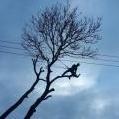After viewing Nailer's vid a wise man said this about crown reductions -
'Having done thousands of similar reductions over a 15 year period & seen the results I really dont think there is a great concern of long term detriment to their health. I have observed that most return to similar volumes of foliage in 12 months, but on a reduced framework, or you could say a re-engineered structure less prone to failure due to reduced leveraged loading of branches & stems.
Yes, for the most part from the tree's perspective they could happily be left alone at 0%. And when large parts fail thats OK. There is no target present & the parts can lay on the ground at the base of the tree & decompose.
But that is not the real world for the urban arborist.
As arborists we are ususally working on trees to help a tree fit in with human needs, desires, values & most often, fears-founded or not.
Of all the crown reduction pruning I have done, only a handful have enquired asking for it.
Most are topping or removal requests, usually founded on the fear of failure of large trees with fairly good structure-eg. not major defects.
So if a 15, 20, 25 or even 30% reduction from the tips inwards (not interior) helps to reduce major & secondary lateral branch or leading stem failures, and ease the concerns of the customer, and prevent the next guy from coming along & topping it or talking them into removal because thats all they're good at, then I think a 25% crown reduced tree is quite an ok option. Better than 100% to ground level.
Managing trees is a fine balance between health & structure.
If you focus too hard on one, you'll likely jeopordise the other.
5% is gonna do stuff all to improve a trees structure & help prevent failure.
50% is gonna detract from the trees health. But that is also not to say that there can be cases where in the trade off of heath vs structure it could still be the best thing to do to save a tree from removal, in some cases.
Vigor of the species in general & the individual specimen need to be taken into account.
But on the otherhand, a heavily over-loaded, over-extended major scaffold branch may be lost all together to failure equalling a greater % loss than had it been pruned enough to prevent the failure. There is also the potential for that failure to tear out at the union & make a massive irrepairable wound to the piece it was attached, resulting in that needing to be removed too.
It does take skill to both sell & perform this type of work compared to the alternatives.
I don't know about you, but i'd have a hard time running a profitable tree service if I ran around doing 60 quotes a week and told them all that they should just leave their trees alone & not worry about it because their tree knows best and it really doesn't need us.'


.jpg.e78d23f57b029caf0a7282c8ab545f75.jpg)






